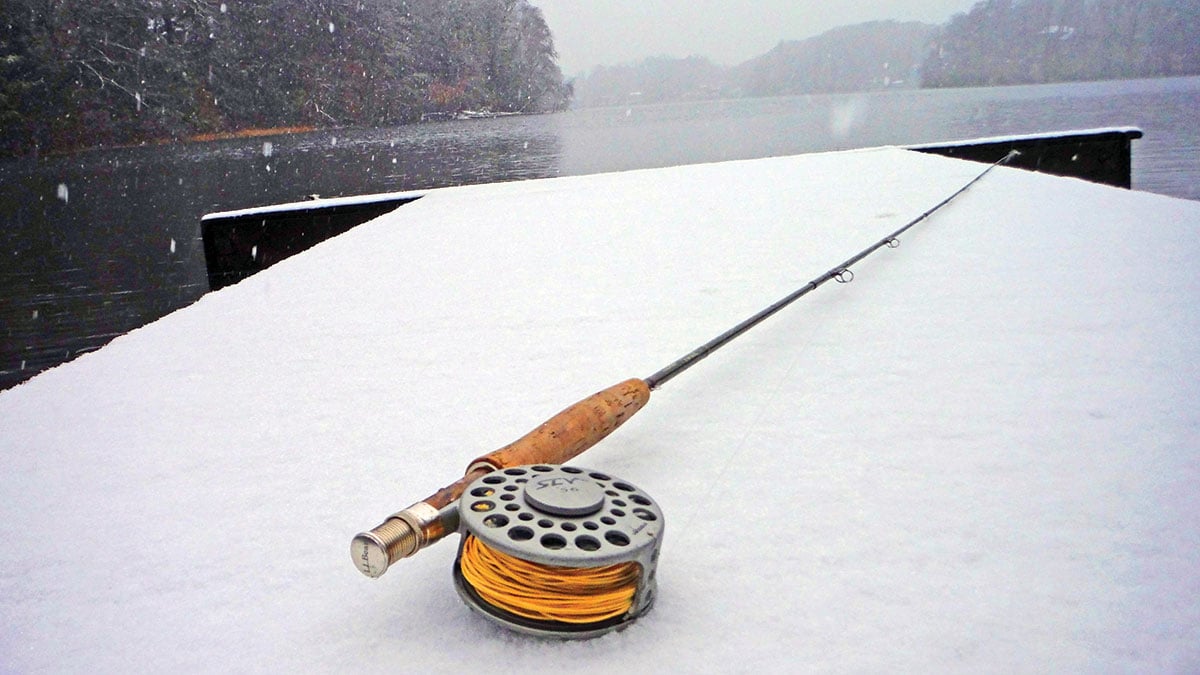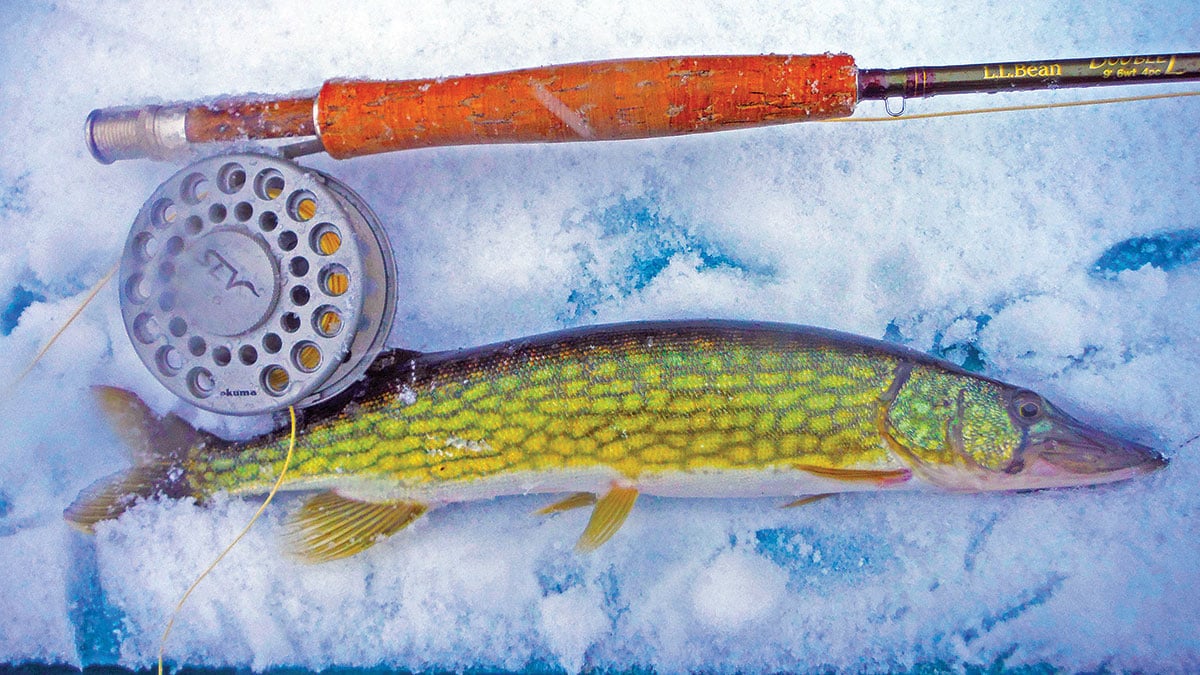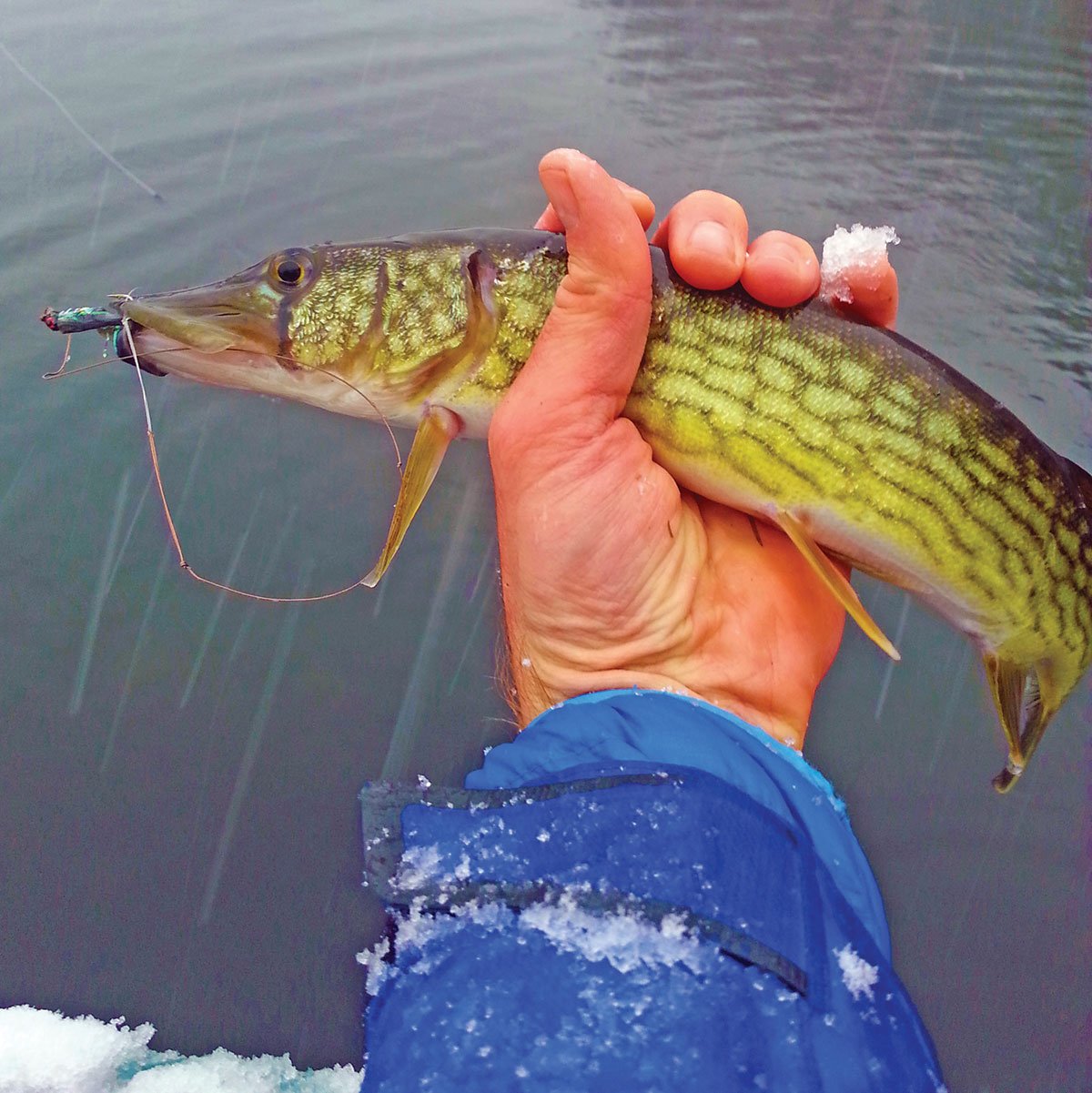With open-water options waning in the 12th month, the lowly pickerel offers an excellent opportunity to put a bend in your rod.
December is a big transition month for anglers in New England. In November, there are still plenty of fishing opportunities. Some of the largest bass, pike, and trout of the year can be landed during November, and I have had some really fun surf fishing nights during this month as well. However, by mid-December, “skunkings” start to happen more frequently and conditions and water temperatures can really deteriorate. For those that don’t ice fish, opportunities to get out and bend a rod begin to look bleak.
However, there is one angling opportunity available that I believe is often over-looked and underappreciated. We have a native fishery here in New England that is available all year to the vast majority of anglers all across New England—the pickerel. Perhaps some of you are rolling your eyes as they often get a bad reputation during the summer for destroying gear and not fighting particularly hard in comparison to a bass; however, hear me out, as I think they are one of the most underappreciated fish in our local waters.

First, pickerel are ferocious native predators that are aggressive and willing to take a variety of lures and flies. Fast, strong, and occasionally very acrobatic, the large ones can definitely test your light to moderate-weight tackle. Further, they can be found in a vast array of habitat and are distributed across all of New England. They can be found in small ponds, large lakes, rivers, streams, beaver ponds, and man-made reservoirs; just about everywhere!
Pickerel are also a moderate to cold-water fish, preferring early and late season water temperatures, and they are very tolerant of winter-time temperatures as well; as such they are a targeted and respected ice-fishing species. Since they can be found in a huge variety of water-ways, and can be caught virtually all year long, they offer a winter fishing opportunity that is accessible to anyone. You probably only live 20 minutes or less from a body of water with a healthy population of pickerel in it, no matter where you live in New England. No need to drive hours to find reliable action at a striper holdover spot, or winter trout fishing area.
While they can be caught on anything that you would throw for other freshwater species, I think the very best way to target them is with a fly rod. Fly fishermen this time of year are even more limited in their options to bend a rod, and the pickerel offers a viable and entertaining option for those who want to continue fishing into the New Year. From boat or shore, pursuing these fish this time of year can be very rewarding. They can still hit hard when it gets cold, and often launch into acrobatic jumps and shockingly fast runs that would rival many other species; yes, even in December! Indeed, there are even late-season sight-fishing opportunities for those who are willing to put in the time to find the right spots. For me, there is something really special about sight fishing for a native fish in a snow storm, with a fly rod, while everyone else is at home complaining about the weather. And as a bonus? This time of year gives a shot at hooking a personal best: it’s a time when the biggest fish try to put on the last bit of weight before winter gets a firm grip. Trust me when I say, that fighting a 4- or 5-pound pickerel on a fly rod is very entertaining.
Where to Look
While they can be found in many different water bodies in New England, pickerel tend to group up and congregate this time of year in specific portions of ponds, lakes, and river pools. Above all else, I look for them in heavily-vegetated coves and bays; places that would be considered “very weedy” during the summer time. If you enter into a likely area but don’t catch any fish in 15 minutes or so, move on. Once you find a few fish, work that area carefully to take advantage of the congregated fish. I tend to only focus on areas that I know have produced, and will “camp out” on a spot if I catch a few fish. This has resulted in my most consistent catch-rates.

The great thing about these fish for the fly fisherman is the fact that they stay shallow this time of year too; there’s no need to dredge the deep-water drop-offs with sinking lines. Look for water that is somewhere in the area of 4 to 10 feet deep; although some ice fishermen will urge you to look a little deeper, and I have also caught them in only a foot of water. Darker bottoms are great because they capture what little solar energy is still available from the sun, and these bottoms often go hand-in-hand with the highly vegetated areas. That’s about as complicated as it gets for me in terms of finding a spot. Fish around all the same structure you would for bass as well: stumps, trees, boulders, etc. Really focus on putting the fly in every likely nook and cranny. While they will move around to investigate any prey options, they are more inclined to hit the fly this time of year if you put it right in front of their nose.
Weather-Permitting
As you likely suspect, this time of year the weather and temperature can make or break a fishing trip. As mid-December starts to approach, only sunny and mild days produce for me. Well, let me qualify that by saying those are the days that typically produce sufficient strikes to make cold hands worth it. As I’ve stated numerous times, the really fun thing about pickerel is they can be caught literally every day of the year; it is only limited by how hard you want to work for that bite. However, without a lot of patience and live bait, colder days this time of year can be insufferably slow on action.
Since I enjoy fishing with the fly rod, I look for days that are in the mid-40s and particularly like periods where we have a string of sunny days. I like late in the afternoon and prior to sunset; this gives the water the maximum time to warm up during the day. This time of year usually means driving directly from work to the water if you have an early schedule, or saving fishing for the weekend if you work a “9 to 5.” Interestingly, I still find that those days with a low-pressure system moving in can result in a little bump in the hook-up ratio, so fishing during a snow storm may actually result in more fish landed. It can also result in some pretty memorable times on the water.
Stick to the K.I.S.S. Principle
In all my fishing, I try to adhere to the KISS principle: keep it simple, stupid! However, during this time of year I try even harder to stick to the basics and be efficient. There are only limited windows of opportunity, and if pickerel are going to bite they are not that fussy. I don’t want to waste time with lots of different flies or gear. There’s no reason to go out and buy anything special for this fishing; any rod between a 4- and 7-weight will work. However, over the last half a decade I’ve moved away from a 9-foot, 6-weight and now use a 7-foot, 4-weight rod. I prefer the lighter rod as the fight is more challenging and enjoyable on these fish, and it’s still plenty robust enough to ensure you’re not injuring the fish by over-playing it. I give the nod to a slightly faster rod as it makes casting streamers with a wire-tippet more efficient. But really, there are no wrong options here. I recently purchased a slow action glass rod that I can’t wait to use in this application, although I didn’t buy it specifically for this.
I fish a weight-forward floating line exclusively and typically a 1x, 2x or 3x tapered monofilament leader. This strength of leader (specifically a 1 or 2x) is definitely over-lining on a 4- or 5-weight rod, but I like using it as it matches up better to the requisite bite-wire I use. Without the extra thickness of a 1 or 2x leader, I find the knot breaks very easily when tied to the wire; there is very little or no stretch to the wire, and I believe this leads to knot fatigue. The extra strength also helps if you’re fishing in weedy coves, as it helps in ripping the fly out of the “sticky” bottom. Don’t worry about extra-long leaders, these fish are generally not overly fussy (hence the bite-wire being a non-issue in my experience). I like Rio’s tie-able wire tippet in 20-pound, but there are other excellent options. I join the wire to the leader with a simple uni to uni knot. Go slow in tying the knot and it will slide together nicely, and the wire will sync up perfectly with the monofilament leader. If you insist on not using bite-wire, be prepared to lose flies or fish a heavy 30-pound monofilament tippet and be forced to re-tie frequently; not always very much fun when it’s so cold out.

As for flies, any streamer in sizes 1/0 to 8 will work, there is no need to get fancy. Since I prefer a 4-weight rod this time of year, I usually fish size two to six flies. I really like Zonker Rabbit-Strip flies. The allure of the pulsating rabbit-strip tail and the flashy, thick body really appeal to the pickerel’s instincts, and they hold up well to all those sharp teeth. However, I use a lot of Black-Ghosts, Clouser Minnows, and Wooly Buggers for all the freshwater species I fish for, and these also work excellent for pickerel. Basically whatever is in my box at the time, I fish. However, I do find that a fly with a bit of flash works best with pickerel.
I think that altering the fly size and presentation matters a lot more than the actual pattern. While bigger is often better, I sometimes find this time of year that going smaller can work as well: it’s all about experimentation. As for the delivery and action of the fly, I encourage you to try a variety of stripping motions. This has made the largest difference in my hook-up ratio. I default to a slow, strip-pause-strip, retrieve; but that doesn’t always work. Often, letting the fly hang still for as long as possible works best, and just letting it sink almost to the bottom before imparting any action can be deadly. Always hold on to that line and be ready, as they often hit it on the “dead stick” – no movement at all. Other times they will only strike on rapid, erratic stripping motion; yes, even in December sometimes “fast and loose” induces a strike. Be flexible, and don’t get stuck on the same old pattern!



